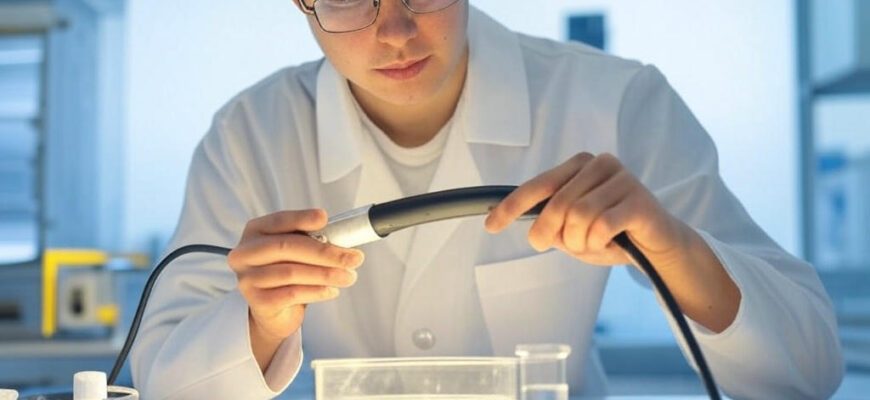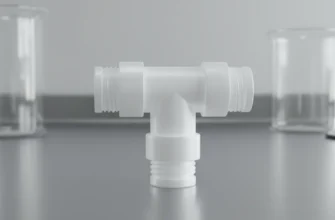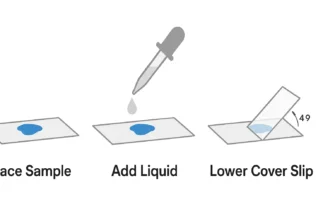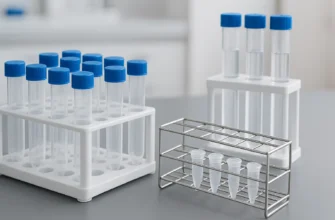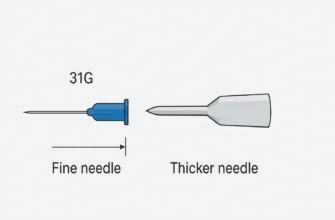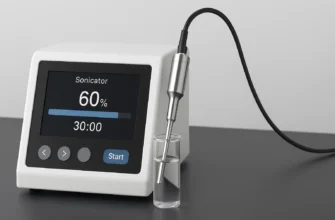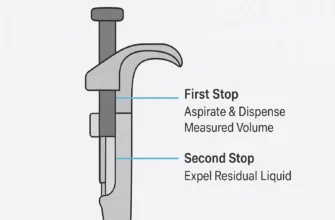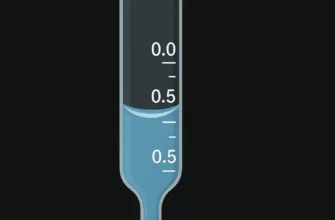Essential Micropipettes for Genetics Field Work: Ensuring Precision in DNA Analysis
DNA analysis and genetic research demand extreme precision when handling microscopic sample volumes. For field geneticists working outside traditional laboratory settings, selecting the right micropipettes is crucial for obtaining reliable results. This comprehensive guide explores the essential micropipettes for genetics fieldwork and demonstrates how precision pipetting ensures accuracy in DNA analysis applications.
Understanding the Principles of Micropipettes
Micropipettes operate based on the principle of air displacement. They utilize a piston and seal within the pipette body to aspirate and dispense liquids. When the plunger is depressed, the piston moves downward, creating a partial vacuum that draws liquid into the pipette tip. Releasing the plunger expels the liquid, with the volume transferred determined by the piston displacement and adjustable via the volume dial.
A micropipette that can accurately handle very small volumes of liquid is an essential tool for genetic testing. For context, while measuring cylinders are appropriate for large volumes (e.g., 1 L), micropipettes are specialized instruments designed for the microliter world where genetics research operates. The effect of error is significantly greater when the total volume handled is smaller – a drop of ink in 1 L water barely changes color, but the same drop in 1 mL creates a dramatic difference, illustrating why precision matters so critically in genetic applications.
Genetic testing typically requires transferring solutions to different containers and mixing liquids repeatedly. Micropipettes are designed for continuous use with disposable tips, allowing quick and repeated operations without washing, which is particularly valuable in field conditions.
Types of Micropipettes for Genetic Applications
There are two fundamental types of micropipettes to consider for genetic fieldwork:
Fixed Volume Micropipettes: These measure only one specific volume and are:
- Less expensive than variable models
- Easier to use for beginners
- Ideal for standardized procedures like electrophoresis experiments
- Available in common sizes like 10 μl and 4 μl
Variable Volume Micropipettes: These can be adjusted to measure different volumes within a range:
- Offer more flexibility for diverse protocols
- Essential for advanced procedures like PCR
- Available in common ranges: 1-10 μl, 2-20 μl, 20-200 μl, and 100-1000 μl
- Necessary for sophisticated genetic analysis protocols
For most genetic fieldwork, researchers need at least two variable micropipettes (typically 2-20 μl and 20-200 μl) to cover the range of volumes commonly used in DNA protocols.
Selecting Micropipettes for Genetic Fieldwork
Portability and Durability Considerations
Field conditions demand equipment that can withstand transportation and variable environments. The emergence of portable PCR equipment like the miniPCR thermocycler has proven effective for field experiments, suggesting similar considerations apply to micropipettes. When setting up portable genetic analysis capabilities, researchers should prioritize:
- Lightweight, compact micropipettes
- Durable construction that withstands field transport
- Models that maintain calibration despite environmental changes
- Equipment that operates reliably without specialized support infrastructure
For limited-resource settings, some researchers recommend seeking quality used equipment to maximize budget efficiency. While this approach can be effective, reliability must never be compromised for critical genetic applications.
Volume Range Requirements for Genetic Applications
The specific volume ranges needed depend on particular genetic applications:
- PCR and qPCR setup: 2-20 μl range for precise addition of templates, primers, and enzymes
- DNA extraction protocols: 20-200 μl range for buffers and reagents
- Reagent preparation: 100-1000 μl micropipettes for stock solutions
- Precise DNA template addition: 0.5-10 μl pipettes for small volume applications
A critical consideration emerging from laboratory practice is to avoid pipetting volumes below 1 μl whenever possible, even with appropriate micropipettes. At extremely low volumes, accuracy becomes increasingly problematic regardless of equipment quality.
Precision Pipetting Techniques for DNA Analysis
Best Practices for Accuracy in Genetic Applications
The scientific community has developed numerous techniques to ensure precision in genetic work:
- Spin-down technique: Briefly centrifuging tubes (5 seconds) moves solution from tube walls to the bottom, allowing complete sample recovery for pipetting.
-
Sample tracking systems: When handling multiple DNA samples, use tip positions in the box as markers to track progress systematically.
-
Appropriate pipette selection: Always use the smallest suitable volume pipette for maximum accuracy – don’t use a P1000 for 150 μl (use P200 instead), and don’t use a P20 for 1 μl (use P2 instead).
-
Pre-wetting tips: Aspirate the solution 3-5 times before actual sample aspiration to improve accuracy with valuable DNA samples.
-
Proper handling technique: Keep pipettes vertical when pipetting DNA and don’t submerge tips too deeply to maintain consistent volumes.
-
Speed control: Scientific studies demonstrate that pipetting speed significantly affects accuracy – faster handling results in lower volume delivery. The recommended approach is “slow is smooth, smooth is fast”.
Common Errors and Solutions in Genetic Sample Handling
Several pipetting errors can compromise genetic analysis:
- Volume limitations: Never pipette below the minimum recommended volume of your micropipette. Setting a 20 μl pipette to 0.1 μl is “basically setting it to zero and seeing what happens” – the actual volume dispensed could be anywhere from 0-2.5 μl, making genetic results completely unreliable.
-
Serial dilutions for tiny volumes: For extremely small volumes of precious genetic material, create serial dilutions to work with larger, more manageable amounts that can be pipetted more accurately.
-
Angle effects: Research shows that changing delivery and aspiration angles affects accuracy. Maintaining the delivery angle at 30° and aspiration angle at 90° produces optimal results.
-
Tip compatibility: Use manufacturer-recommended tips for optimal fit and accuracy in DNA work. Mismatched tips can create inconsistent seal and aspiration problems.
Applications in Genetic Testing and Research
PCR and qPCR Setup
For Polymerase Chain Reaction (PCR) setup, precision is essential. Micropipettes enable the precise addition of DNA templates, primers, nucleotides, and polymerase, ensuring accurate and reproducible amplification of specific DNA sequences.
For quantitative PCR (qPCR), specialized techniques improve accuracy:
- Use reverse pipetting for master mix (prevents bubbles) and forward pipetting for cDNA samples
- Consider placing cDNA at the bottom of wells and adding master mix to the side to facilitate mixing without contamination
- Run triplicates instead of duplicates for more statistically reliable results
- Dilute DNA samples to avoid pipetting very small volumes that introduce variability
Experienced laboratory scientists recommend: “When you set up a full plate of PCR, put in your mastermix via reverse pipetting (it is more accurate for repeat pipetting), no bubbles, but then when you drop your sample in via forward pipetting (normal way), mix a few times, then go to 2nd stop and deliberately blow out a bubble. Boom, no more ‘did I accidentally skip that well?'”
DNA Extraction and Quantification
For DNA quantification, accuracy in pipetting directly affects standard curves and final measurements. Research demonstrates that pipette systems exhibit high accuracy and precision for forensic applications such as DNA quantification and genotyping assays.
A comparative study on pipette tip performance showed that molecules like DNA tend to bind to polypropylene pipette tips, leading to errors and transfer losses. Therefore, selecting high-quality tips that minimize retention is crucial for accurate genetic work, particularly in field conditions.
Field-Based DNA Analysis
When performing DNA analysis in the field, researchers have successfully used portable equipment like the miniPCR alongside the Oxford Nanopore Technologies MinION for gene sequencing. This combination enables PCR amplification of DNA “barcodes” used for species identification outside traditional lab settings.
The ability to perform accurate pipetting in field conditions has enabled researchers to conduct DNA extraction, amplification, and even sequencing in remote locations, revolutionizing biological field research capabilities.
Ensuring Accuracy and Reproducibility
Calibration and Maintenance for Field Operations
Regular calibration remains essential for micropipette accuracy, even in field settings:
- Laboratory practice typically includes scheduled calibration (e.g., every January with verification checks in October)
- Performance studies indicate calibration uncertainties for micropipettes in good working condition vary between 0.1% and 0.2%
- Field calibration can be verified through simple tests like weighing dispensed water volumes or through portable spectrophotometry if available
Quality Control Measures for Field Genetics
Several quality control practices improve reliability in field settings:
- Multichannel approaches: For consistency across multiple samples, using multichannel pipettes improves reproducibility when processing field samples
-
Thorough mixing and spinning: Mix solutions thoroughly and spin plates when possible to eliminate bubbles that affect volume accuracy
-
Volume optimization: Dilute samples to work with volumes of at least 2-4 μl rather than sub-microliter amounts that introduce variability
-
Replication strategies: Use triplicates rather than duplicates for critical genetic measurements
-
Temperature considerations: Field temperature variations can affect pipetting accuracy, so allow solutions and equipment to equilibrate when possible
Latest Innovations in Micropipette Technology for Field Genetics
Recent advances in micropipette technology have improved field usability:
- Ergonomic designs: Modern manufacturers offer lightweight, ergonomically crafted micropipettes to minimize hand fatigue during prolonged use in field conditions
- Versatile configurations: Both fixed and variable volume options cater to diverse field requirements with increasing portability
- Improved accuracy: Current micropipettes achieve higher precision even at lower volumes, critical for genetic applications with limited sample availability
Field-friendly options: Compact, portable micropipettes specifically designed for fieldwork increasingly complement other portable genetic technologies
Conclusion: Optimizing Micropipette Selection for Genetic Fieldwork
The selection of appropriate micropipettes for genetic fieldwork requires balancing several factors:
-
Accuracy requirements: For DNA work, highly precise measurements are essential, particularly for PCR and sequencing applications that form the backbone of genetic analysis
-
Volume ranges needed: Most genetic protocols require multiple volume ranges, with particular attention to accuracy at lower volumes where errors have greater impact
-
Portability considerations: Field conditions demand durable, lightweight equipment that maintains calibration during transport and works reliably in varied environments
-
Quality control integration: Field protocols should incorporate verification steps to ensure pipetting accuracy despite challenging conditions
By understanding the principles of micropipettes and implementing best practices for precision pipetting, researchers can ensure accurate and reproducible genetic analysis even in challenging field conditions. As portable genetic technologies continue to evolve, the integration of appropriate micropipettes with field-friendly DNA analysis tools further expands the possibilities for genetic research beyond traditional laboratory settings.
Applications Across Genetic Research Fields
Precision micropipettes are essential across diverse areas of genetic fieldwork, including:
- Conservation genetics: Accurately processing environmental DNA samples to monitor endangered species
- Agricultural genetics: Field testing of crop varieties and pathogen identification
- Medical field research: Point-of-care genetic testing in remote locations
- Ecological monitoring: On-site DNA barcoding for species identification
The right micropipette becomes not just a tool but a critical enabler of reliable genetic science beyond the confines of traditional laboratories, opening new frontiers in our understanding of genetic diversity worldwide.

